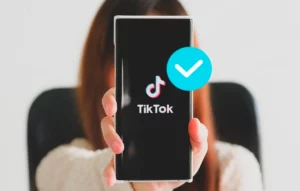It’s undeniable that social media has become a vital marketing channel for organizations of all types and sizes. However, you may be contemplating its effectiveness regarding school promotion.
Can you really leverage social media to stand out in the educational landscape? Absolutely, you can!
A survey by the NAIS shows that 63% of elementary schools regard social media as one of the most effective digital marketing channels for driving new student leads. Using social media for schools helps significantly helps in boosting enrollment, make stronger community partnerships, and increasing parent involvement.
On the flip side, every school – private or public – has been using and knows the power of social media for schools. This means it is extra challenging for your school to stand out from the crowd and build its presence.
But don’t worry!
This guide will revolutionize your social media strategy, helping you engage with your community more effectively and elevate your school’s online presence.
Let’s dive right in!
Why is Social Media Marketing Important for Schools?
Whether you represent a public school, a private institution, or a district seeking to expand youxr reach, the benefits of social media marketing are undeniable.
Utilizing social media for schools goes beyond the scope of just admissions. You can establish your school as a dynamic and influential presence in the community by showing its values, achievements, and overall brand identity.
Still unsure if social media is the appropriate platform for your school? Let’s delve into some key benefits to dispel your doubts:
1. Highlight Your Best Side
Social media is a powerful tool to highlight the best facets of your school, effectively transforming it into a recognizable brand. You may think branding sounds ostentatious for a school, but that’s precisely what your competitor schools have been aiming to achieve through their social media presence.
A solid social media presence invites prospective students and parents actively seek school-related information. Keep your school at the forefront of their minds by sharing success stories, student achievements, extracurricular activities, and other highlights of your school life.
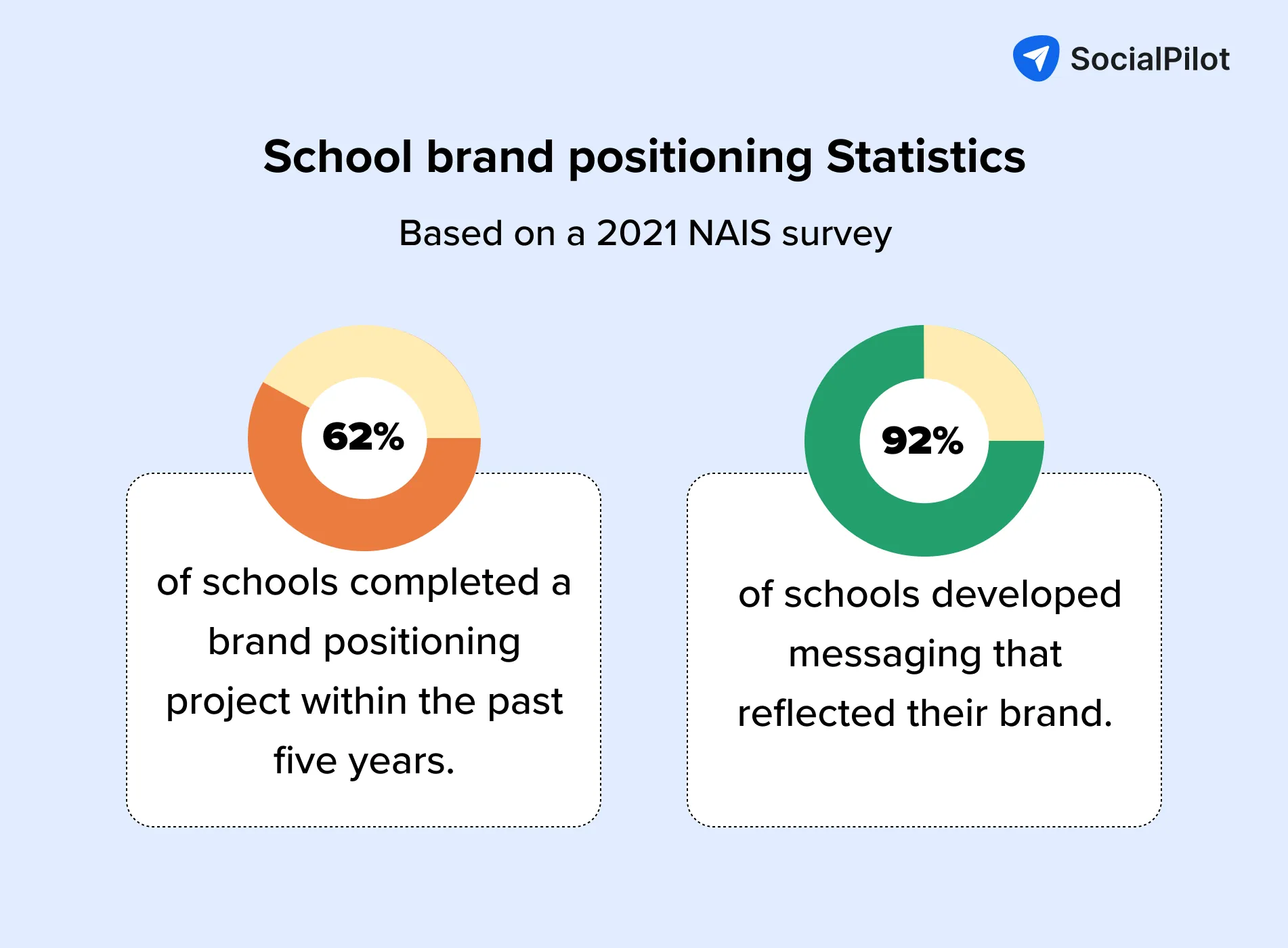
As an established school brand on social media, you attract prospective students and parents who are actively seeking information about schools. You can stay on top of their mind by sharing success stories, student accomplishments, extracurricular activities, and other positive aspects of your school.
2. Make a Connection With the Parents
As a school, your aim stretches beyond attracting parents to admit their children to your school. You need to involve parents in their child’s educational journey actively.
That’s where social media platforms offer an accessible and convenient means of communication between schools and parents. With social media, you get a direct line of communication with parents, leading to improved parent engagement and satisfaction.
Start by sharing vital updates, academic calendars, or event details on your school’s Facebook page. Post visual content on Instagram capturing parent-teacher meetings, workshops, or parent participation in school events. This active interaction allows parents to feel more involved in their child’s school life, enhancing overall satisfaction.
3. Connect With Students
Beyond parental engagement, social media serves as an effective communication tool with students.
Suppose your email and class announcements aren’t gaining traction. In that case, social media becomes an alternative communication channel. Use platforms popular among students, like Instagram and Snapchat, to post class activity updates, share homework reminders, or celebrate student achievements.
Moreover, sharing posts about school events, field trips, or student achievements allows students to engage in discussions and express school pride. This can improve communication and foster a stronger sense of community among your students.
4. Encourage Social Proof
Social proof plays a critical role in shaping your school’s reputation and attracting new admissions. Effective social media use can build a community that drives social proof effectively.
Trust is a vital factor for prospective parents, and 54% of people in a survey claimed that feedback from other parents on social media influenced their decisions.
But how do you prove this on social media?
Schools can share testimonials, reviews, and feedback from students, parents, and community members on social media platforms to reinforce their credibility.
4 Social Media Platforms for Schools to Reach Audiences
Understanding the potential of social media is crucial. Let’s explore which platforms can best serve your school’s promotional needs.
1. Harness the Power of Facebook
If you could only select one platform for your school’s social media promotion, it should be Facebook.
Despite various emerging platforms, Facebook remains dominant among all age groups, particularly adults. An impressive 81% of all U.S. adults possess a Facebook account, making it an exceptional platform for parent communication. Unsurprisingly, 93% of schools utilize Facebook for marketing.
Its expansive user bases, familiarities, and diverse features, such as groups, reviews, and live videos, make it the perfect launchpad for your school promotions.
2. Engage With Instagram’s Visual Appeal
While Facebook primarily attracts parents, Instagram provides the opportunity to connect you with parents and students. Its visual orientation provides an ideal space for showcasing school life, student achievements, and events via images and short videos.
Instagram has a balanced Gen-Z and millennial user base, with 70% of users under 34. Its vibrant environment particularly appeals to these younger demographics. That’s why If your school district includes middle school, junior high, or high school students, it is worth using Instagram to foster stronger connections and enhance engagement with them.
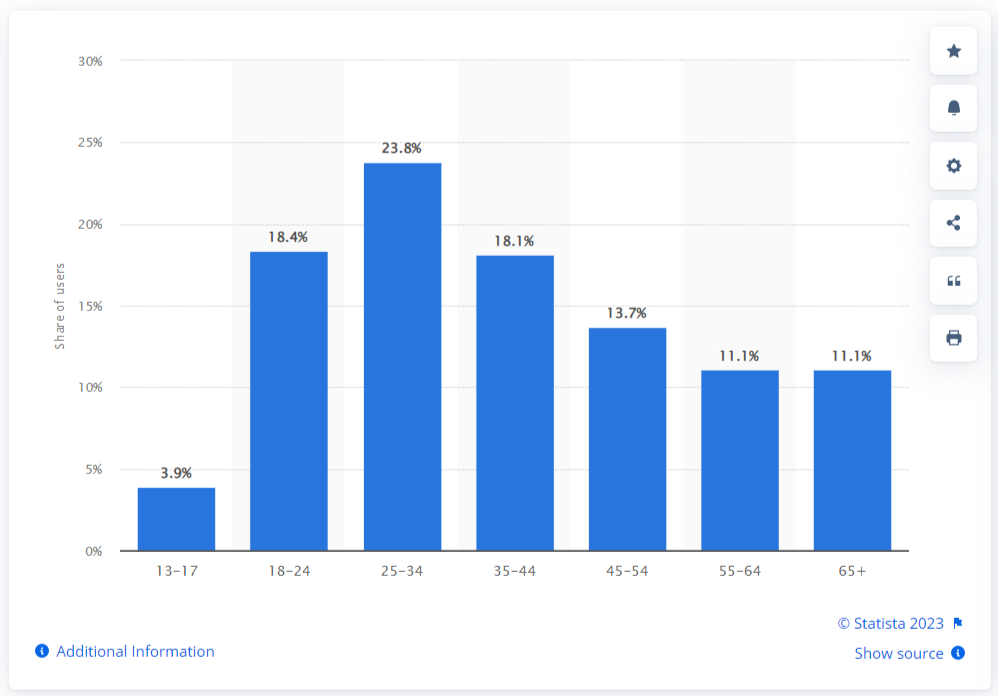
You should also know that overall, the education industry is exploding on Instagram, with higher education having the highest engagement rate out of any industry on Instagram, at 2.99%. So, placing your bets on Instagram will be a fair decision.
3. Leverage YouTube for Educational Content
Did you know that YouTube ranks second in popularity among social media platforms in the US, only surpassed by Facebook?
YouTube is a fantastic platform for schools to connect with prospective parents and students. The video-centric platform makes it easier for parents to get in-depth information about schools and foster trust.
But that’s not it.
YouTube is also popular among students; recent statistics reveal 96% of Gen Z and 87% of Millennials in the US have YouTube accounts.
You can leverage the platform by creating informative and engaging videos on school events, student performances, and educational videos.
4. Enhance Communication With Twitter
Twitter, as a platform, is known for its nature to provide information quickly and concisely. Many school districts use the platform to share important information with parents as most of Twitter’s audience (38.5%) belongs to the 25 to 34 age group.
You can use Twitter to share quick announcements, news, and educational resources with students and parents. Twitter also recommends using the platform’s accessibility to make things easier for parents and students by sharing safety, availability, finance tips, and nutrition info.
Now that we’ve explored the best social media platforms to boost your school’s online presence, it’s time to build a comprehensive strategy to make the most of these platforms. So, let’s dive into seven helpful tips that can help you create a social media strategy for schools.
7 Tips To Create a Fool-Proof Social Media Strategy for Schools
Crafting a solid social media strategy is not merely about having a presence on the platforms; it’s about utilizing them in the best possible way. To assist you in this endeavor, here are seven foolproof tips to guide your school toward creating a compelling social media strategy.
Let’s explore this one by one.
1. Set a S.M.A.R.T. Marketing Goal
Setting a marketing goal is the first step you need to take to create a successful social media marketing strategy for your school.
So, what will your social media marketing goals be?
Firstly, your social media goals must be aligned with your overall business objectives. Here are some common goals for schools to consider:
- Increasing enrollment
- Improving parent communication
- Enhancing brand awareness
- Showcasing student achievements
Secondly, you must set specific, measurable, achievable, relevant, and time-bound (SMART) goals to guide your strategy.
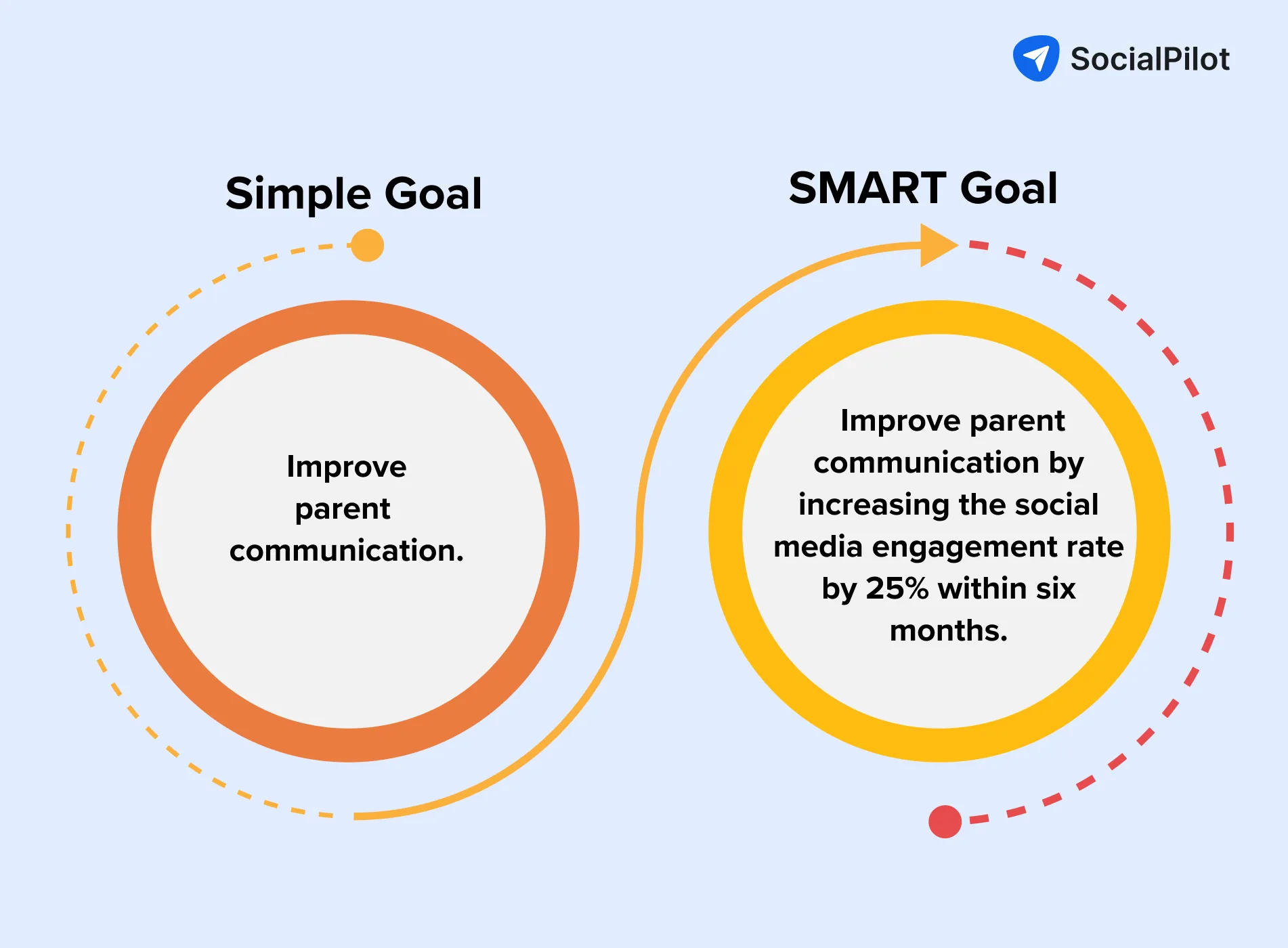
2. Learn from Competitors
An essential part of creating a compelling social media strategy is keeping track of what your competitors are doing on social media. Observing how comparable schools utilize social media can provide you with a wealth of information.
Look for schools in your local area or those with a similar target audience and observe their strategies, content types, and engagement tactics. The process will give you valuable insights to implement in your strategy to help your school stand out from the crowd.
For example, if a competitor school’s posts about their sports teams are getting high engagement, it might be worthwhile to spotlight your own sports program. Conversely, if you notice a competitor receiving criticism for not responding to comments or queries on their social media posts, it highlights the importance of proactive communication in your own strategy.
Additionally, competitor analysis can help you identify gaps in your competitor’s strategies that you can leverage. Perhaps there’s a platform they’re not utilizing, a type of content they’re not creating, or a segment of the audience they’re not addressing. By filling these gaps, your school can stand out and provide unique value to your target audience.
3. Choose Your Social Media Platforms
We have already covered every social media platform where you can start doing social media for your school. But it doesn’t mean that you must start on them together.
Why?
While it can be tempting to establish a presence on every platform, it’s more beneficial to focus your efforts on a few key platforms that align with your school’s goals and demographic.
For instance, if your only objective is to attract new students, platforms like Instagram and Snapchat, which have a younger demographic, could be effective. Facebook, with its broad user base, is excellent for building and nurturing a community of parents, students, and staff. LinkedIn, meanwhile, can be an excellent platform for connecting with alumni and potential staff hires.
Start by analyzing the demographic data of different social platforms and align these with your target audience’s profile. This will ensure you’re dedicating your resources to the platforms where you will most likely reach and engage your target audience.
In addition, consider the nature of the content you plan to share. If your school frequently holds events and you have plenty of photos and videos to share, a visually driven platform like Instagram would be an excellent choice.
Remember, it’s not just about being on the platform; it’s about how effectively you can engage your audience on it. By focusing on fewer platforms, you can better understand the nuances of each and optimize your strategy accordingly.
4. Come Up With Different Content Ideas
Social media is where people log in to gobble funny, entertaining, and engaging content they like. So tailor your content to each social media platform’s format and audience preferences.
Also, you need to try out a variety of content to capture the attention of parents, students, and your community.
But that’s the tough part – keeping things exciting every time.
To help you out, here are some amazing content ideas you can use for your school’s social media marketing:
a. Put Your Students in the Spotlight
Your current students can be your best selling point.
Highlighting their achievements, sharing their stories, and focusing on their experiences can help parents see the benefits of enrolling their child in your school.
But it’s not just about showcasing academic prowess.
Highlight many accomplishments, such as sporting achievements, artistic talents, community service efforts, and more.
This way, prospective parents will get a sense of how well the current students of your school are doing. This also further demonstrates your drive and commitment to nurturing well-rounded individuals.
But that’s not it.
Acknowledging these achievements can inspire other students and reinforce a sense of school pride.
Here’s an example:
Roosevelt High frequently spotlights its students’ diverse achievements, from science fair victories to volleyball championship wins. Here is a post on their Instagram where they celebrate one of their student’s achievements.

b. Take Your Audience Behind the Scenes
Showing behind the scenes of your school makes it easier to connect with prospective parents and students and show them your educational environment. Additionally, this peek behind the curtain can demystify your school’s operations, making it feel more accessible and welcoming.
Share images and videos from different parts of your school – hallways, classrooms, labs, fields, and more and show how vibrant and dynamic life is at your school. Make sure you’re highlighting both academic and extracurricular activities, emphasizing the balance of learning and fun in your institution.
For example:
Northbrook/Glenview School District often give their followers a look inside their music class, highlighting the interactive and fun learning process.
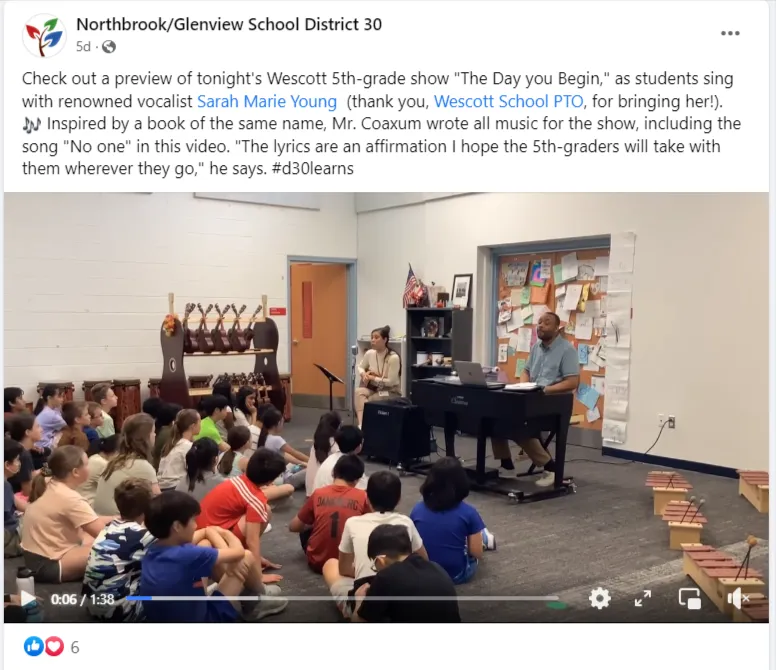
c. Share Events and Celebrations
You know that the events and celebrations happening at your school are pretty fun. But the world doesn’t. Sharing moments like upcoming school events, celebrations, or special days such as open houses, graduation ceremonies, or themed days on social media can help create a sense of excitement and belonging among your audience.
Use these posts not only to report on the event but also to thank participants and acknowledge the effort behind the scenes.
d. Use Interactive Content
Every social media platform has many features to make your content interactive and encourage participation. Such content can boost audience engagement and foster a sense of community.
You can use Facebook and Instagram story stickers or simple feed posts to Incorporate polls, quizzes, contests, and challenges into your social media strategy. Use these features to run contests or crowdsource opinions.
You can also create education-related quizzes to engage both students and parents, making learning a fun and shared experience.
For instance, a history quiz on Instagram stories, or a math problem challenge on Facebook, can create an engaging learning experience while also encouraging users to share the content with their own networks, thereby broadening your reach.
5. Create a Social Media Calendar
You can only be consistent on social media with pre-planning. A social media calendar enables you to create a well-documented posting plan in advance.
With a calendar, you get an overview of all the upcoming dates and events relevant to your school. Be it holidays, school activities, important deadlines, community events, or national observances, you can plan and define a content strategy for each occasion in advance.
Inside the calendar, you will have to create:
- A separate tab for each social platform
- Post copies and creative assets
- Best date and time to post
- URLs and hashtags included in the posts
Start by using a simple social media calendar template or use social media calendar tools. A calendar tool will not only help you create a plan but also help you schedule posts in advance.
Are spreadsheets incapable of holding your multi-platform posting plan? Don’t worry. SocialPilot will make it a breeze!
Use SocialPilot’s calendar feature to organize and overview weeks and months of posting plans for all your social media platforms under a single dashboard. Its drag-and-drop feature makes it easy to change any post’s time and date quickly.
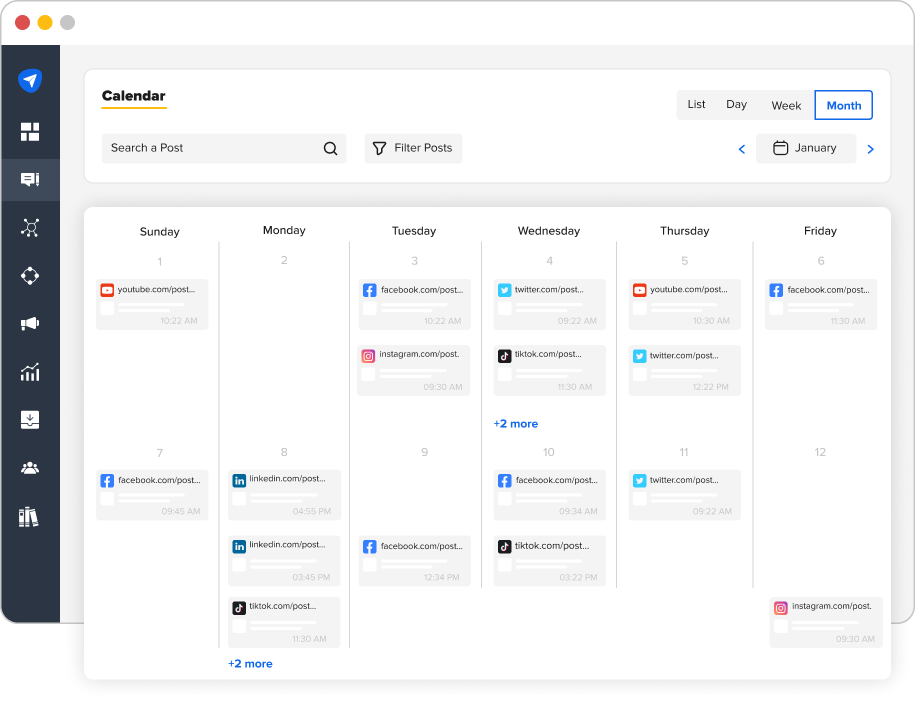
6. Engage With Your Audience
Social media platforms require more than just posting to make your school stand out. If you need to build a prolific community on social media, then you need to engage with your followers; make them feel seen, heard, and valued.
At the very least, you must encourage your followers to like, comment, and share your post. If they interact with your posts in such a way, then social media algorithms will show the same post on the timeline of other people they follow, which expands your community.
So how do you boost engagement?
- Prompt response: Reacting swiftly to comments or direct messages shows your audience that you value their input. Even a simple acknowledgment can go a long way in fostering goodwill and loyalty.
- Encourage participation: Ask your followers about education, school activities, or general interest topics. This encourages them to share their opinions and experiences, creating a vibrant, interactive social media community.
- User-generated content: Invite followers to share their experiences, photos, or stories about your school. This kind of user-generated content can offer authentic insights into your school culture and encourage a sense of ownership and participation among your followers.
- Use live features: Live videos are an excellent way to share real-time updates and behind-the-scenes moments or even host Q&A sessions. They provide an authentic, in-the-moment interaction that can uniquely engage your followers.
- Seek reviews: Request your students’ parents to leave a review on your Facebook page. These reviews can serve as credible testimonials for prospective parents and help foster trust.
Tired of juggling between different platforms to respond to the messages and comments of your followers?
You can do better.
Use SocialPIlot’s Universal Inbox to bring the comment section and inbox of multiple social media channels under one roof. Easily streamline all your interactions from reviews, ratings, visitor posts on your pages, comments, messages, and more.
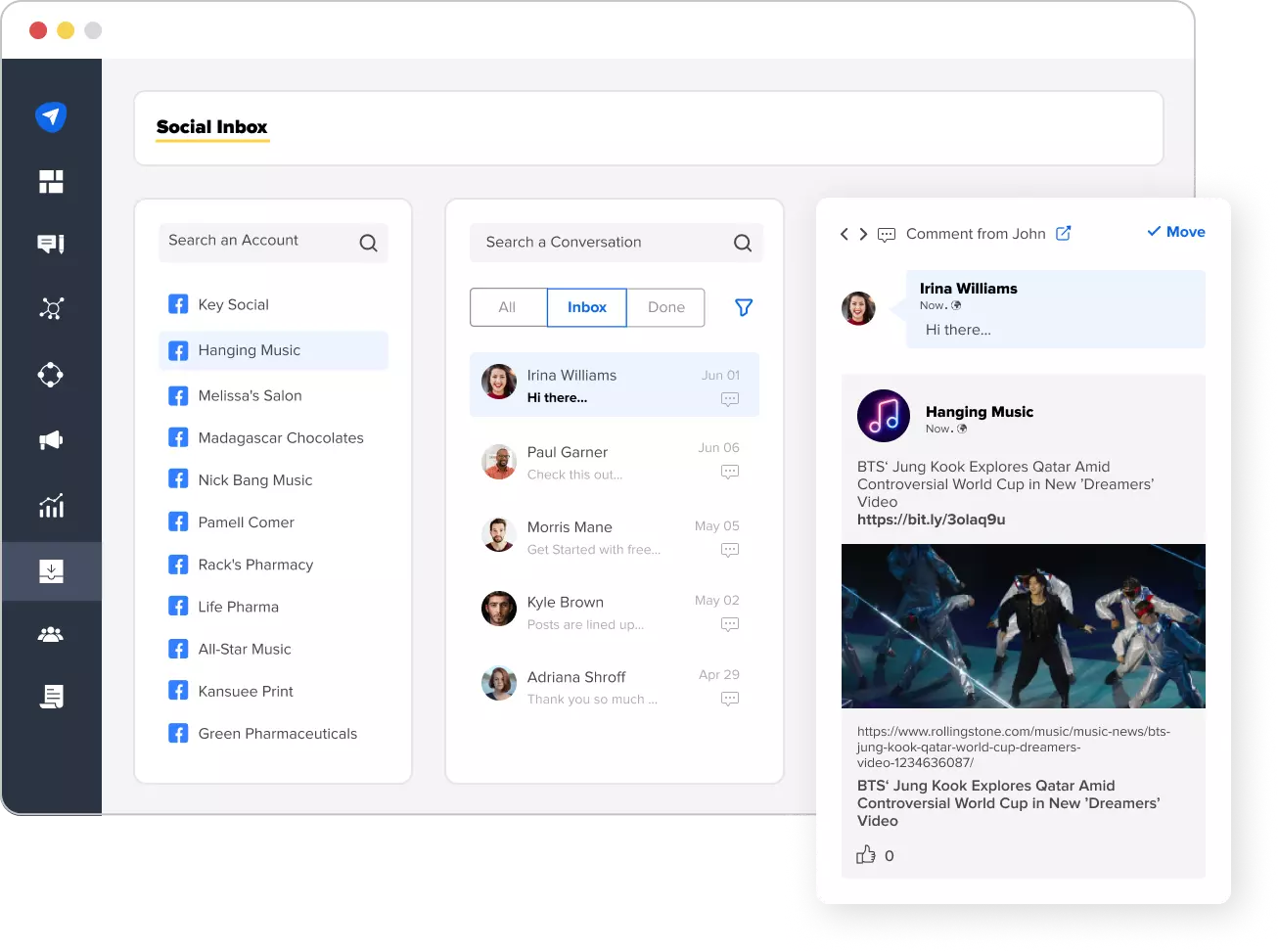
7. Make a Facebook Group for Families and Students
Almost every school creates a separate Facebook group to connect with parents, students, or staff members to share experiences, ask questions, and support one another.
Facebook groups provide an excellent platform for nurturing a close-knit community around your school.
Here’s how you can leverage this feature for your school:
- Parent groups: Create a group for parents to share experiences, ask questions, and support one another. For example, Aldama Elementary has a Facebook group specifically for parents, allowing them to engage in open dialogue and receive school updates directly.

- Engagement in groups: Apart from sharing school-related information, encourage active participation within the group. Invite members to start conversations, ask questions, and share their thoughts. This makes the group a lively forum for discussion rather than just a broadcast channel for announcements.
- Student groups: Consider creating separate groups for students. These can be used as virtual classrooms where you can live-stream lectures, discuss academic topics, assign homework, and provide important class updates. Such groups can help create a cohesive classroom culture, even when students are not physically together.
All this talk about social media strategy across so many platforms can be daunting for one school to handle, isn’t it? But what if we said there’s a simple and easy tool to handle all your social media accounts?
Well, here is…
SocialPilot: The Best Tool to Manage Your School’s Social Media Marketing
Managing social media marketing for schools can be time-consuming. Schools often have accounts on multiple social media platforms, which makes it challenging to manage all of them effectively.
To make it tougher, putting a district in the equation makes things more overwhelming.
The complexity multiplies as the district oversees multiple schools, each with its unique social media presence. Managing all these individual accounts under the district’s umbrella can be even more challenging.
That’s where a tool like SocialPilot comes in!
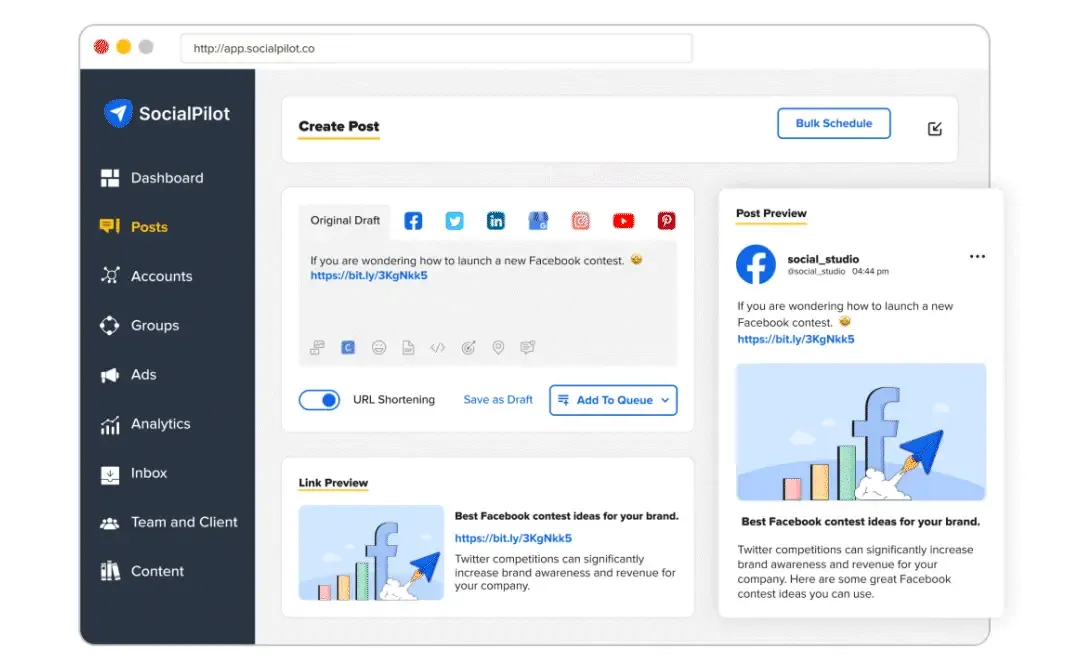
SocialPilot is a social media management tool that helps you hit all your social media marketing goals.
It offers:
- Multi-platform support: Easily connect and manage all your district’s or school’s social media accounts on a single dashboard.
- Social Media Scheduling: Plan and schedule posts in advance for multiple social networks of your school at once. This saves you time and ensures a consistent presence on social media. You also get customization options to tailor your content to suit each platform’s specific requirements of each platform.
- Analytics: Understand the performance of all your social media platforms to make newer strategies quickly.
- Collaboration: Invite and collaborate with your team on individual social media posts. You can also assign different roles to team members to create a smooth approval and feedback workflow – all inside on tool.
Conclusion
One thing is for sure – social media is a pivotal marketing platform for schools. Its influential role extends from driving enrollments, fostering community partnerships, and enhancing parent engagement.
So, whether you’re just starting your social media journey or looking to enhance your school’s existing strategy, embrace the power of social media for your school.
Take the insights and tips from this guide, and don’t forget to leverage the power of SocialPilot to manage and optimize your school’s social media efforts effectively.

